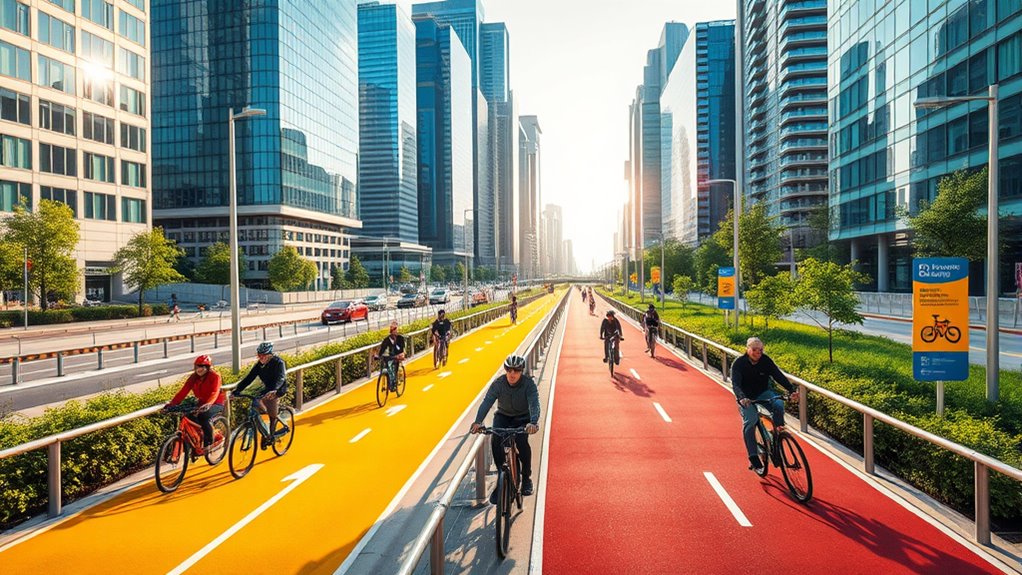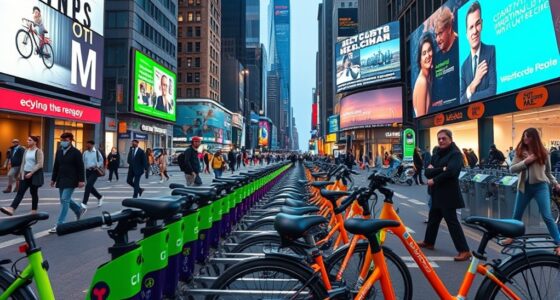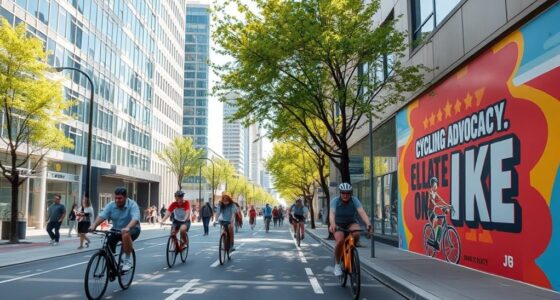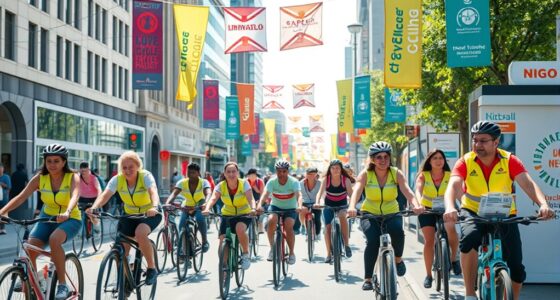Successful cycling infrastructure around the world showcases innovative urban planning, community engagement, and policy support. Cities like Copenhagen and Utrecht feature extensive, protected bike lanes and smart traffic systems, boosting safety and usage. Seville rapidly expanded its network, increasing ridership markedly, while Brussels and Salt Lake City benefited economically from bike-friendly projects. Rural efforts in Mozambique and urban initiatives in Addis Ababa promote broader accessibility. Keep exploring to discover how these strategies can inspire your own city’s transformation.
Key Takeaways
- Copenhagen’s extensive curb-separated cycle tracks and green routes significantly boost cycling modal share and urban mobility.
- The Netherlands’ mandatory, segregated bike lanes and large parking facilities exemplify safe, predictable cycling infrastructure.
- Seville’s rapid expansion of protected lanes increased daily cyclists from 6,000 to over 70,000, demonstrating infrastructure’s impact on usage.
- Utrecht’s large bike parking and prioritization of cyclists promote high daily bike usage and safety through smart traffic management.
- Salt Lake City’s protected bike lanes boosted retail sales, property values, and reduced urban crash rates, illustrating economic and safety benefits.
Copenhagen, Denmark: Innovative Transportation and Comfort Features
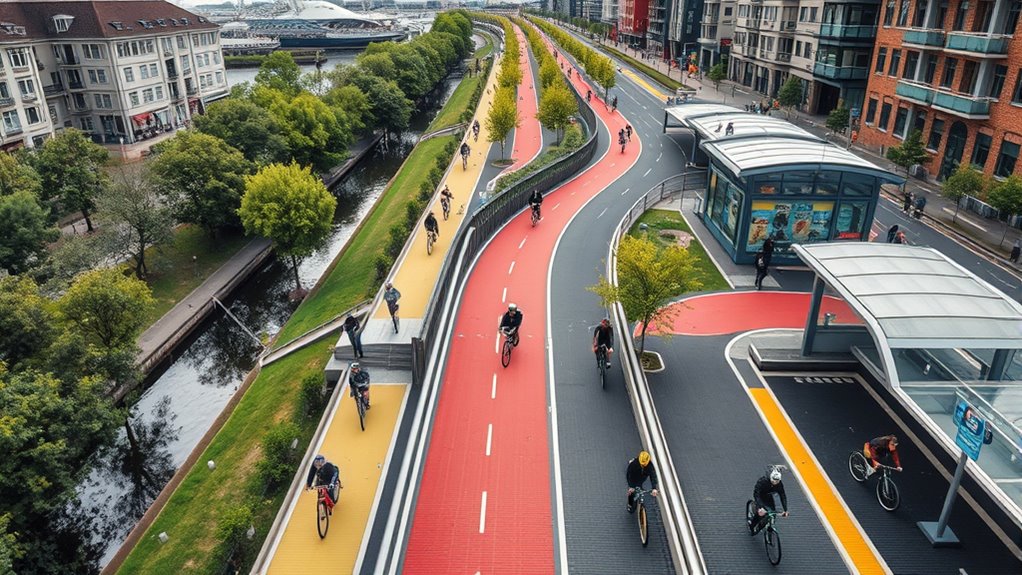
Copenhagen has established itself as a global leader in cycling infrastructure by prioritizing innovative transportation features that enhance comfort and safety. You’ll find curb-separated cycle tracks forming the backbone of the network, with over 350 km of dedicated lanes separated from pedestrians and vehicles by curbs. Symmetric street layouts with one-way cycle tracks on both sides of main roads make navigation straightforward. Green routes, spanning 43 km through parks, offer car-free commuting options that blend seamlessly with urban life. The city plans to expand this network by adding 70 km of new cycle tracks and 67 km of green routes by 2026. Suburban areas like Albertslund also feature 83 km of separated bike alignments, including bridges and tunnels, ensuring safe, comfortable cycling across the entire metropolitan region. Emphasizing sustainable materials, Copenhagen continues to develop its infrastructure to meet the needs of eco-conscious cyclists and actively promotes dynamic communication exercises to encourage community engagement in sustainable transportation initiatives.
The Netherlands: Car-Free Bike Lanes and Mandatory Use
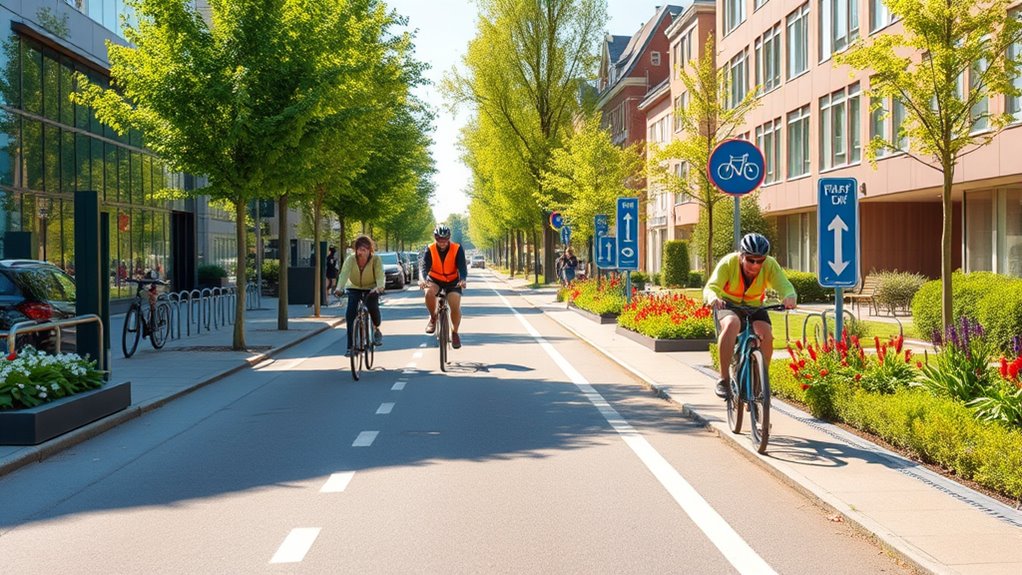
The Netherlands has built an extensive and highly regulated cycling network that emphasizes safety and seamless connectivity. Over 35,000 km of dedicated cycle paths, often marked with red asphalt or bricks, ensure clear separation from motor traffic. The country’s commitment to space optimization and organized infrastructure supports a smooth cycling experience. Mandatory use of segregated bike lanes is enforced by law, making cycling safer and more predictable. Many routes run parallel to roads for uninterrupted travel, and urban areas feature raised lanes at intersections with distinct traffic signals for bikes. Shared roads, labeled “Fietsstraat auto te gast,” give priority to cyclists, while 60% of roundabouts include separated cycle tracks. The country also offers extensive parking facilities, like Utrecht’s 12,500-bike garage, and integrates cycling with trains through secure parking and dedicated carriages. These measures make cycling a safe, convenient, and legally prioritized mode of transportation.
Seville, Spain: Rapid Network Expansion and Ridership Growth
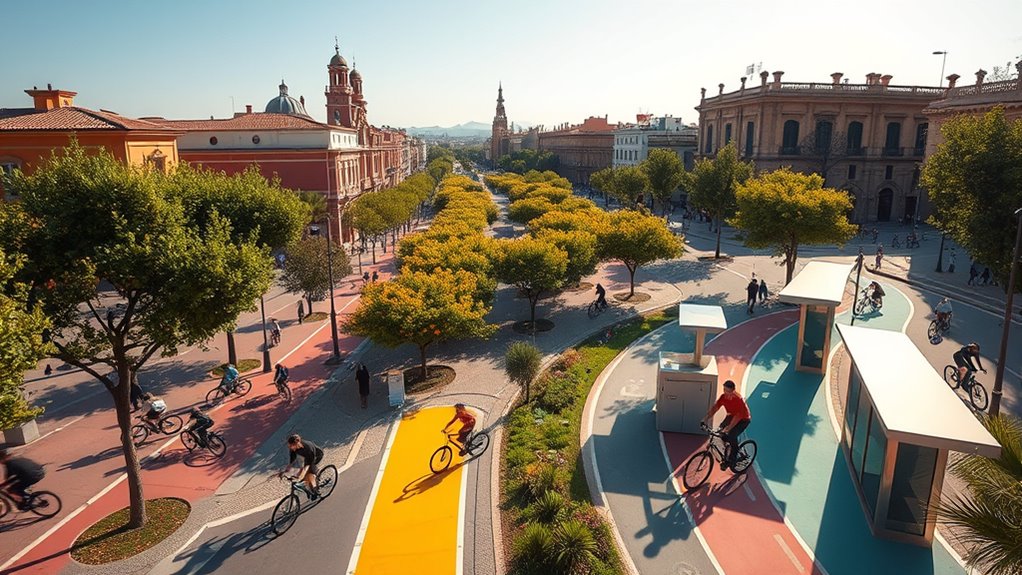
Seville’s rapid expansion of cycling infrastructure has transformed the city’s mobility landscape in just over a decade. Starting with 80 km of protected lanes in 2006-2007, the network grew to 120 km within four years, boosting cycling’s role in daily transportation.
Today, over 180 km of protected lanes connect key areas, making cycling a practical and preferred option. The city’s modal share jumped from 0.5% to 6% between 2007 and 2011, with daily cyclists soaring from 6,000 to more than 70,000.
The introduction of the SEVici shared bicycle system made bikes accessible and affordable, further encouraging ridership. A 2017 plan aims to reach 15% modal share, and ongoing expansion continues to improve mobility, accessibility, and environmental sustainability across Seville.
Karachi, Pakistan: Critical Mass Rides and Community Engagement
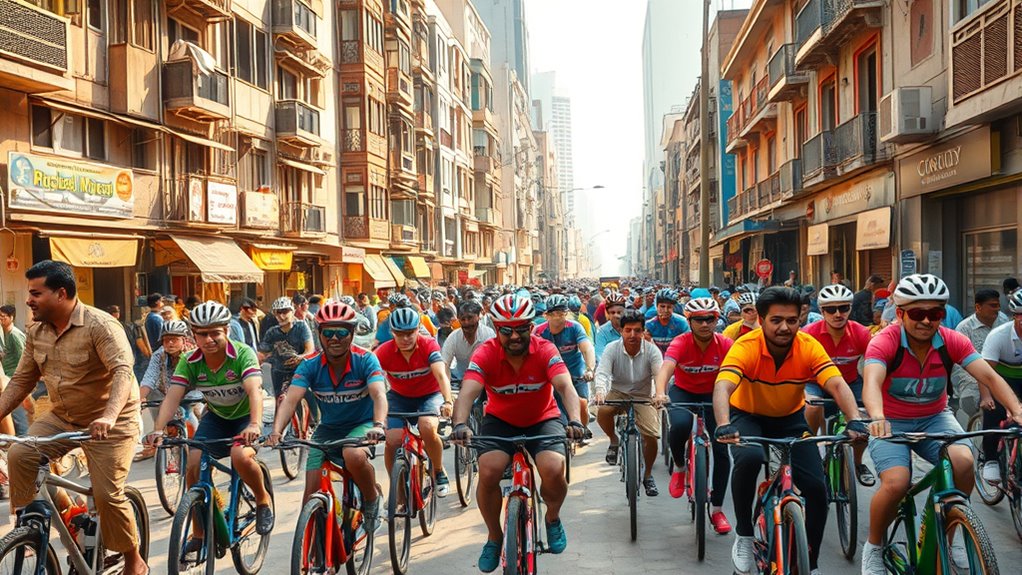
Since its inception in 2009, Critical Mass Karachi has become an essential movement that promotes cycling as both recreation and social expression. You’re part of a vibrant community with around 14,000 Facebook members, organizing rides every other Sunday that draw 200 to 350 participants. These community rides promote awareness of cycling’s benefits and encourage inclusivity, especially for women who see cycling as a way to challenge societal norms and gain independence. Special rides for beginners and children help newcomers learn safely, with experienced members guiding the way. Despite Karachi’s lack of dedicated cycling infrastructure, the group’s advocacy and visibility foster social change and challenge gender stereotypes. Their efforts demonstrate how community engagement can influence cultural perceptions and create momentum for future infrastructure development. Incorporating community-led initiatives such as these can be a powerful catalyst for advocating improved cycling infrastructure in cities like Karachi. Additionally, these grassroots efforts can influence policymakers by demonstrating the demand for dedicated cycling infrastructure and fostering a supportive environment for change. Recognizing the importance of personal development strategies can also empower members of these communities to sustain their advocacy and adapt to challenges. Furthermore, understanding public health benefits related to cycling can motivate broader participation and support for infrastructural improvements. Engaging with advocacy strategies can help communities better communicate their needs to decision-makers and accelerate policy change.
Mozambique: Rural Bicycle Access and Connectivity
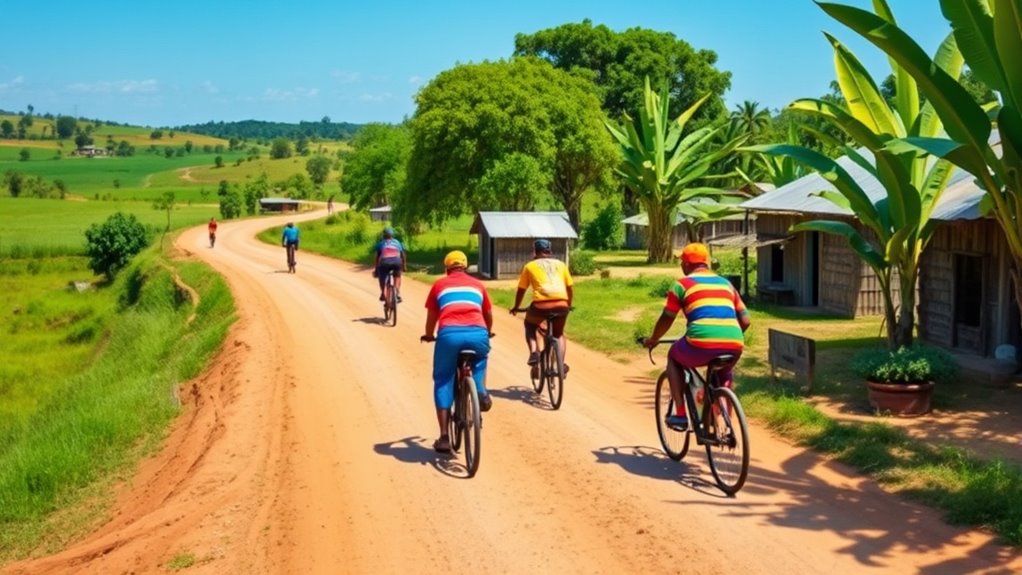
In rural Mozambique, bicycles play a vital role in improving access to essential services and economic opportunities. They reduce travel times to schools, clinics, and markets, helping children attend school consistently and communities access healthcare more easily.
Bicycles also support economic stability by enabling adults to reach markets and sustain jobs. Since walking is the primary mode of transport, bicycles offer a faster, more efficient alternative, especially for transporting heavy loads like produce. Incorporating skilled manufacturing practices can enhance bicycle quality and durability, further benefiting rural users.
Initiatives like MOZAMBIKES and partnerships with organizations such as ExxonMobil have distributed bicycles, fostering community development and boosting income for farmers and entrepreneurs. Additionally, addressing infrastructure challenges is crucial to maximize the benefits of bicycle access in rural areas. Building dedicated cycling paths can enhance safety and encourage more residents to adopt bicycles as their primary mode of transport.
However, rural areas lack proper infrastructure, and affordable, quality bicycles remain scarce. Developing sustainable solutions and expanding bicycle access could profoundly transform connectivity and economic prospects in Mozambique’s rural communities. Improving bicycle infrastructure is essential to ensure safe and reliable travel for these communities.
Addis Ababa, Ethiopia: Community Initiatives and Bike-Friendly Infrastructure
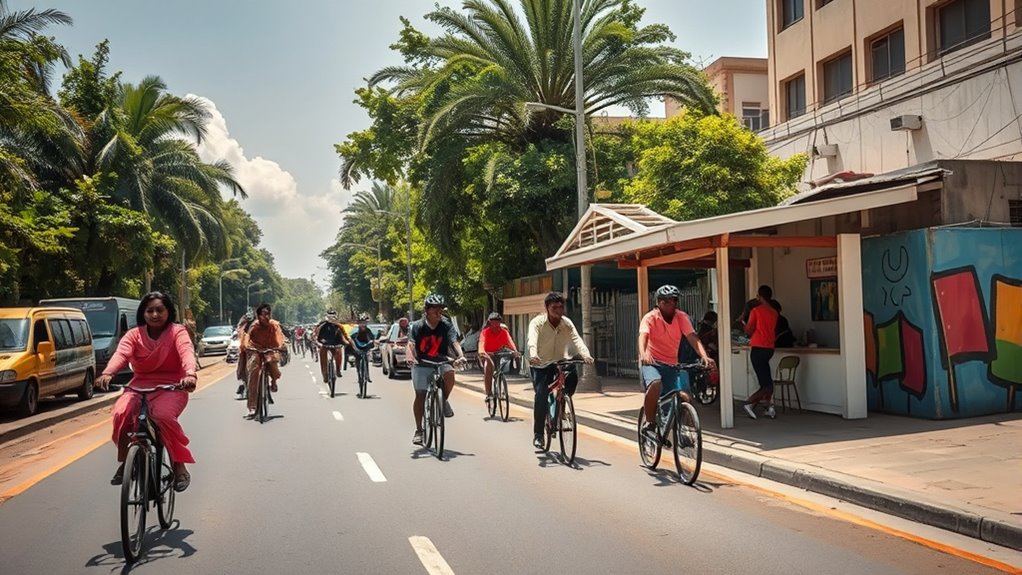
Addis Ababa is actively working to expand its cycling infrastructure as part of its broader Non-Motorised Transport (NMT) Strategy, aiming to develop a 200 km network over the next few years.
The city plans to build 100 km of bicycle lanes within three years, partnering with organizations like ITDP and UN-Habitat to ensure quality planning and implementation. This initiative aims to create safe, accessible routes for cyclists of all ages and abilities, supporting the city’s long-term vision through phased development.
Community efforts focus on promoting equity and economic benefits, making cycling a cost-effective and inclusive transport option. These projects also seek to reduce road injuries, improve air quality, and enhance access to jobs and education, integrating cycling into Addis Ababa’s broader transport system. Voiceover techniques are increasingly used in promotional campaigns to raise awareness and encourage cycling adoption among residents. Additionally, the city emphasizes cycling infrastructure development to facilitate safer and more efficient travel. Developing sustainable transport options is key to achieving long-term urban mobility goals. Incorporating urban planning principles helps ensure that cycling infrastructure complements other transportation modes and promotes sustainable development, especially through the use of innovative design.
Salt Lake City, USA: Protected Bike Lanes and Business Impact

Salt Lake City’s recent investments in protected bike lanes have demonstrated clear economic benefits for local businesses and property owners. After replacing parking with protected lanes on Broadway, retail sales increased, boosting revenue for nearby shops.
Protected bike lanes on Broadway boosted retail sales and supported local businesses.
Property values within a block of cycle tracks also rose, reflecting heightened neighborhood appeal. Importantly, crash rates on 300 South remained stable, avoiding negative impacts from collisions.
Meanwhile, lane reconfigurations reduced urban crashes by 19%, improving safety for businesses. Infrastructure improvements support economic activity near key areas like Pioneer Park and the Fleet Block redevelopment.
Rider behavior shifted, with 41% of cyclists adjusting routes to use protected lanes, while overall bicycle traffic grew during busy hours. These improvements foster a safer, more vibrant environment that encourages both cycling and local commerce.
Utrecht, Netherlands: Accessible and Interconnected Cycling Networks
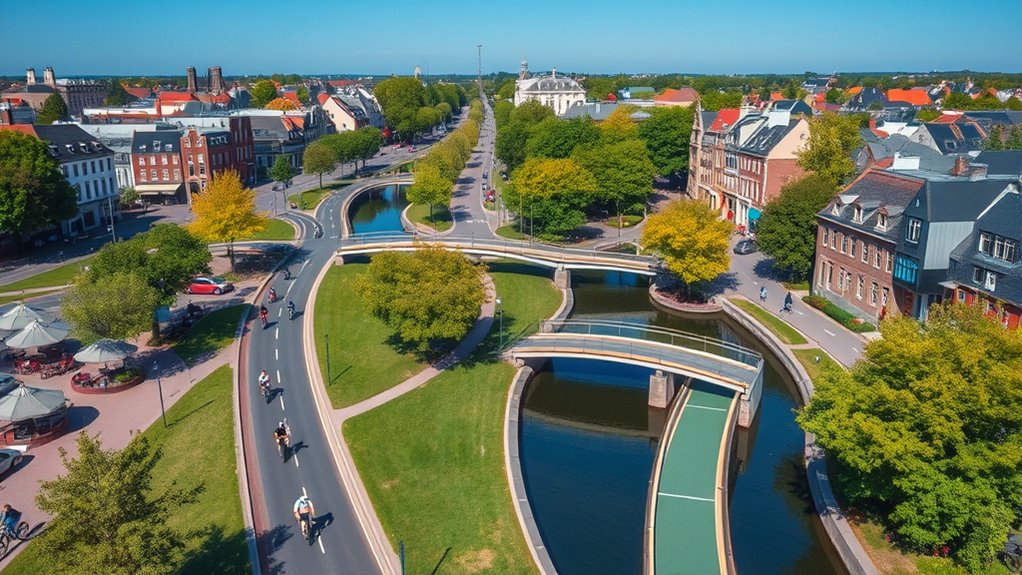
Utrecht exemplifies a city that has prioritized cycling infrastructure for decades, creating an extensive and interconnected network that seamlessly integrates with daily life. Since 1885, the city has continuously developed its cycling routes, expanding to 420 km of dedicated bike paths today. Its commitment has made Utrecht a model for sustainable transportation, supported by the Dutch Cycling Embassy’s recognition. The city’s infrastructure includes the world’s largest bicycle parking facility, with capacity for 12,500 bikes, plus over 30,000 spaces near Utrecht Central Station. Cycling deeply influences local culture, with more than half of residents using bikes daily and over 90% owning one or more, including e-bikes. Strategic traffic management prioritizes cyclists over cars, ensuring safety, convenience, and seamless integration with public transit. Additionally, Utrecht’s comprehensive cycling network exemplifies the integration of dedicated infrastructure with urban planning, fostering a bike-friendly environment that encourages active transportation. Its success is further reinforced by sustainable urban planning, which emphasizes the importance of automated systems and innovative infrastructure to support non-motorized transit options. Incorporating smart traffic management technologies has further optimized flow and safety for cyclists and pedestrians alike. Moreover, ongoing innovations in cycling infrastructure continue to enhance connectivity and promote environmental sustainability.
Brussels, Belgium: Community-Based Projects and Local Economic Stimulation
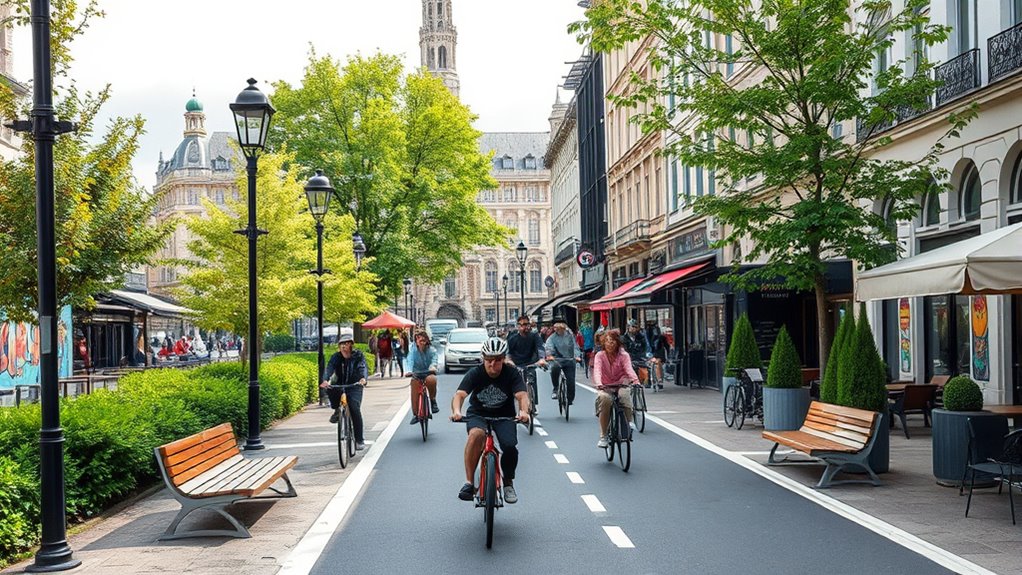
Brussels has actively promoted community-based cycling projects to boost local engagement and stimulate the economy. Through initiatives like the “Bike for Brussels” campaign launched in 2017, residents are encouraged to adopt cycling as a cultural norm.
The city has expanded its cycling infrastructure to include 513 km of paths, with upgrades to pedestrian routes and regional cycle corridors connecting neighborhoods like Uccle and Forest.
Cycling modal share has tripled, reaching 9%, with over 20% of residents cycling weekly.
These efforts support local businesses by improving retail access, creating repair centers, and developing bike parking facilities.
Car-free neighborhoods and safe routes attract tourists and reduce pollution.
Ongoing challenges include ensuring infrastructure coherence, hotspot safety, and secure parking, essential for sustaining growth and economic benefits.
Frequently Asked Questions
How Do Cultural Differences Influence Cycling Infrastructure Success Globally?
Cultural differences shape how cycling infrastructure succeeds worldwide. You’ll find that in some places, cycling is seen as practical and normal, encouraging investment and user-friendly designs.
In others, cycling might be viewed as leisure or status, influencing infrastructure priorities. Local attitudes towards safety, community, and environmental values also determine policy support and public participation, making cultural understanding essential for developing effective cycling systems tailored to each society.
What Funding Models Support Sustainable Cycling Infrastructure Development?
You should explore diverse funding models that promote sustainable cycling infrastructure. Public-private partnerships, like Bloomberg’s initiative, combine funding and technical support.
While government-led mechanisms—state, federal, and climate grants—offer significant resources. International grants, blended finance, developer contributions, health-linked financing, and even revenue from advertising all play roles.
These models help guarantee long-term sustainability by diversifying funding sources and aligning investments with environmental and health goals.
How Is Cycling Safety Prioritized in Diverse Urban Environments?
Oh, sure, because risking life and limb on a bike is just a minor detail, right? In diverse cities, you’re prioritized through dedicated lanes, smart signals, strict laws, and safety campaigns.
Traffic calming measures, cyclist education, and community feedback make sure you’re seen and protected. Local governments understand that a safe environment isn’t a luxury—it’s essential.
What Strategies Promote Cycling Among Marginalized and Underserved Communities?
You can promote cycling among marginalized and underserved communities by implementing targeted strategies. Offer bike education workshops, donate bikes, and create group rides to build skills and social inclusion.
Invest in affordable, protected bike lanes and bike-share systems in low-income areas.
Use multilingual outreach, culturally sensitive programs, and community partnerships to address barriers.
Ensuring safety, affordability, and cultural relevance encourages more people from these communities to cycle regularly.
How Do Cities Measure the Long-Term Economic and Health Impacts of Cycling?
You can measure the long-term economic and health impacts of cycling by collecting data through surveys, feedback, and tracking ridership, sales, and employment.
Comparing areas with and without cycling infrastructure helps identify specific benefits.
Additionally, using economic models and analyzing case studies provide insights into sustained impacts.
Engaging communities and monitoring health outcomes over time are key to understanding how cycling investments improve local economies and public health.
Conclusion
You can see how these cities prove that investing in cycling infrastructure encourages active, sustainable transportation. For example, Utrecht’s interconnected network increased cycling trips by over 50% in a decade, boosting local economy and health. By adopting innovative strategies like protected lanes and community projects, you can help create safer, more vibrant cities. Embracing cycling not only reduces traffic but also fosters stronger communities—making urban living better for everyone.
